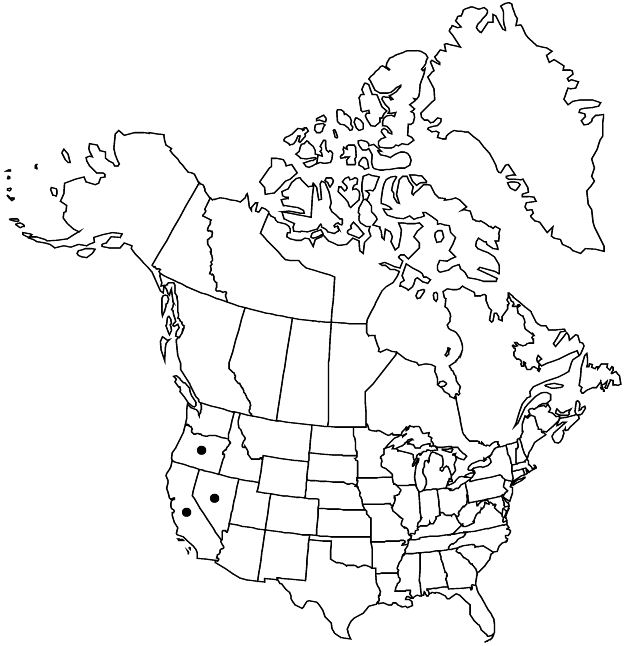Difference between revisions of "Horkelia fusca var. brownii"
Novon 17: 319. 2007.
FNA>Volume Importer |
FNA>Volume Importer |
||
| Line 12: | Line 12: | ||
|label=Endemic | |label=Endemic | ||
}} | }} | ||
| − | |basionyms={{Treatment/ID/ | + | |basionyms={{Treatment/ID/Basionym |
|name=Horkelia brownii | |name=Horkelia brownii | ||
|authority=Rydberg | |authority=Rydberg | ||
| + | |publication_title=in N. L. Britton et al., N. Amer. Fl. | ||
| + | |publication_place=22: 276. 1908 | ||
}} | }} | ||
|synonyms= | |synonyms= | ||
| Line 31: | Line 33: | ||
|elevation=900–2000 m | |elevation=900–2000 m | ||
|distribution=Calif.;Nev.;Oreg. | |distribution=Calif.;Nev.;Oreg. | ||
| − | |discussion=<p>Variety brownii here takes the place of var./subsp. pseudocapitata as used in D. D. Keck (1938) and most floras; this variant was included within <i></i>var.<i> parviflora</i> by B. Ertter (1993d). The diagnostic feature is the ash gray leaflets, which also tend to be more narrowly cuneate than in other varieties. The variety occurs from Mount Shasta in Siskiyou County east to southwestern Modoc County and southeast to Sierra Valley in Plumas and Sierra counties, California, skirting the range of <i></i>var.<i> tenella</i>. Morphologically comparable plants occur as far south as the California-<i>Nevada</i> border on the south side of Lake Tahoe, and at least one collection from <i>Nevada</i> (Reno, Hillman s.n., POM) is closest to this variety. Populations from the southeastern end of the range tend to be larger and less ash gray than those in the vicinity of Mount Shasta. Most references to <i></i>var.<i> brownii</i> (as var./subsp. pseudocapitata misapplied) from Oregon are probably best attributed to the polymorphic <i></i>var.<i> parviflora</i>, but at least one collection from Klamath Lake (Newberry s.n., GH) fits well in <i></i>var.<i> brownii</i>.</p> | + | |discussion=<p>Variety brownii here takes the place of var./subsp. pseudocapitata as used in D. D. Keck (1938) and most floras; this variant was included within <i></i></i>var.<i><i> parviflora</i> by B. Ertter (1993d). The diagnostic feature is the ash gray leaflets, which also tend to be more narrowly cuneate than in other varieties. The variety occurs from Mount Shasta in Siskiyou County east to southwestern Modoc County and southeast to Sierra Valley in Plumas and Sierra counties, California, skirting the range of <i></i></i>var.<i><i> tenella</i>. Morphologically comparable plants occur as far south as the California-<i>Nevada</i> border on the south side of Lake Tahoe, and at least one collection from <i>Nevada</i> (Reno, Hillman s.n., POM) is closest to this variety. Populations from the southeastern end of the range tend to be larger and less ash gray than those in the vicinity of Mount Shasta. Most references to <i></i></i>var.<i><i> brownii</i> (as var./subsp. pseudocapitata misapplied) from Oregon are probably best attributed to the polymorphic <i></i></i>var.<i><i> parviflora</i>, but at least one collection from Klamath Lake (Newberry s.n., GH) fits well in <i></i></i>var.<i><i> brownii</i>.</p> |
|tables= | |tables= | ||
|references= | |references= | ||
| Line 55: | Line 57: | ||
|publication year=2007 | |publication year=2007 | ||
|special status=Endemic | |special status=Endemic | ||
| − | |source xml=https://jpend@bitbucket.org/aafc-mbb/fna-data-curation.git/src/ | + | |source xml=https://jpend@bitbucket.org/aafc-mbb/fna-data-curation.git/src/f6b125a955440c0872999024f038d74684f65921/coarse_grained_fna_xml/V9/V9_418.xml |
|subfamily=Rosaceae subfam. Rosoideae | |subfamily=Rosaceae subfam. Rosoideae | ||
|tribe=Rosaceae tribe Potentilleae | |tribe=Rosaceae tribe Potentilleae | ||
Revision as of 20:36, 24 September 2019
Stems 1–4.5 dm. Basal leaves grayish, 4–12(–18) cm; leaflets 3–7 per side, narrowly to broadly cuneate, 5–15(–17) × 2–8(–12) mm, usually 1/3–1/2 as wide as long, divided 1/4–1/2 to midrib into 4–6 teeth, surfaces often obscured, ± densely short-villous. Cauline leaves 2–4; leaflets of proximalmost 2–4 per side. Inflorescences grayish or purplish, usually ± congested, sometimes more open, usually comprising less than 1/6 of stem, composed of 5–20(–40)-flowered glomerules, glandular hairs usually not red-septate; bracts acuminate-lobed, often ± obscuring pedicels and flowers even at maturity. Flowers: epicalyx bractlets 1.5–2.5 mm; hypanthium 1.5–2.5 × 2.5–4 mm; petals 2–3(–4.5) mm; filaments (0.2–)0.6–1 mm, usually longer than wide, anthers 0.3–0.5 mm; styles 1 mm. Achenes 1–1.2 mm. 2n = 28.
Phenology: Flowering summer.
Habitat: Dry meadow edges in conifer woodlands, on pumice or sandy or clay soil
Elevation: 900–2000 m
Distribution

Calif., Nev., Oreg.
Discussion
Variety brownii here takes the place of var./subsp. pseudocapitata as used in D. D. Keck (1938) and most floras; this variant was included within var. parviflora by B. Ertter (1993d). The diagnostic feature is the ash gray leaflets, which also tend to be more narrowly cuneate than in other varieties. The variety occurs from Mount Shasta in Siskiyou County east to southwestern Modoc County and southeast to Sierra Valley in Plumas and Sierra counties, California, skirting the range of var. tenella. Morphologically comparable plants occur as far south as the California-Nevada border on the south side of Lake Tahoe, and at least one collection from Nevada (Reno, Hillman s.n., POM) is closest to this variety. Populations from the southeastern end of the range tend to be larger and less ash gray than those in the vicinity of Mount Shasta. Most references to var. brownii (as var./subsp. pseudocapitata misapplied) from Oregon are probably best attributed to the polymorphic var. parviflora, but at least one collection from Klamath Lake (Newberry s.n., GH) fits well in var. brownii.
Selected References
None.